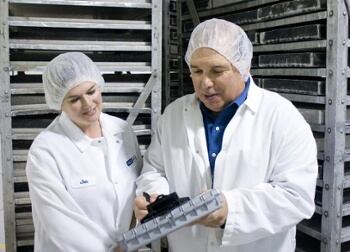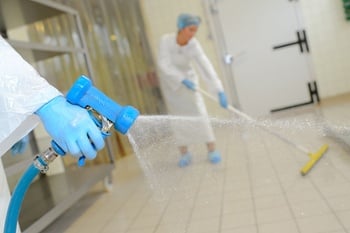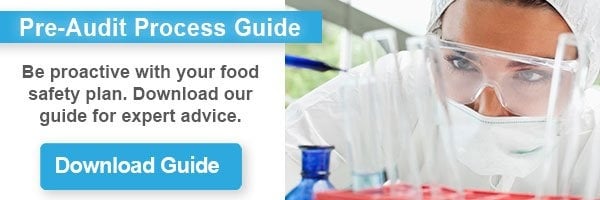What can cause more anxiety for a QA Manager than being paged over the intercom for a “visitor” - only to reach the lobby and find an impatient FDA investigator?
Demand for food safety audits has jumped in recent years due to an increasingly complex global supply chain and expanding supplier requirements. Whether prompted by a consumer complaint or just because it’s your turn, FDA compliance audits are inevitable. If you’re prepared, you will pass your audit with no issues and remove unnecessary stress.
Now more than ever, the FDA emphasizes the entire sanitation process, with the focus on preventing contamination rather than responding to it. Ever since FSMA (Food Safety Modernization Act) was passed into law in 2011 and updated in 2015, the processes of food safety and quality assurance have required substantial changes to a manufacturing plant’s processes.
To get ahead of potential expensive liability and recall issues, take the FDA’s cue. Don’t be reactive - be proactive with your FSMA compliant food safety plan.

Charles Giambrone, RMC Food Safety Auditor Expert (Right),
going over Hygienic Zones with the customer.
How to Prepare for a Food Safety Audit
- CGMP compliance
- What an auditor checks for
- What to do before the audit
- What to do during the audit
- Your role as a QA Manager
1. CGMP Compliance
An important part of regulatory control and the basis for FDA inspections, Current Good Manufacturing Practices (CGMPs) are a great start for any food safety plan. Along with the increased focus on sanitation, the areas of cross-contamination and allergen issues are now under the microscope more than ever.
To meet these requirements, the FDA’s subpart 117 of title 21 CFR requires documented food safety plans to include:
- Hazard analyses
- Prevention controls
- Supply chain programs
- Written recall plans
- Prevention-control procedures
- Corrective action procedures
- Verification procedures
2. What Do FDA Auditors Check For?
We won’t dig into the granular specifics of every way the FDA can ding you for non-compliance - it would take 30,000 words to do that. But it’s advantageous to review the largest and most common problems an FDA investigator looks for.
Current Good Manufacturing Practices (CGMPs)
GMP process violations are some of the most common violations in food safety regulation.
GMPs include practices both behavioral and structural:
- Are employees washing their hands and distancing themselves?
- Are they avoiding cross-contaminating spaces?
- Are supervisors enforcing these rules?
- Are there areas in product zones that could cause microbial issues and contamination?
Facility Infrastructure and Sanitation
Your facilities and operations should resemble a tightly run ship. Structural issues or other building deficiencies endanger not just the consumer, but your staff as well.

Examples include:
- Plumbing issues
- Backflow prevention
- Water leaking
- Cracked drains
- Leaking roof
- Insulation damage
- Pest infestations
The emphasis you place on assessing your facility will probably vary by its age. Notably, many companies move into buildings that need retrofitting - these spaces can come with significant safety challenges.
Allergen Control
Most recalls or chemical hazards are a direct result of allergens. Why? Poor food allergen control leads to cross-contamination, and in a food factory, that’s a recipe for disaster.

Despite this threat, FDA food safety auditors find that some manufacturers lack adequate process control when it comes to allergens. You can bet they’ll look long and hard at your allergen-control practices.
Documentation
If you’re not keeping detailed records, you’re exposing yourself to a real problem.
Past audits should be easily accessible. Yes, that means auditors will expect documentation of past deficiencies, so be prepared.
3. What to Do ‘Before’ the Audit
Every auditor has their unique “thing” they have an especially keen eye for. As such, your FSMA audit preparations should be thorough and wide-ranging - these auditors rotate at least once every 3 years.
What’s the easiest way to do that? Before an FDA auditor is on your doorstep, set up a third-party Safe Quality Food (SQF) audit.
Internal audits should be a part of your plant’s balanced diet. Plan for them on a regular basis, being sure to include:
- Reviews of documentation practices
- Monthly or quarterly paperwork inspections
- CIP (clean-in-place) system validation
- Inspection of signage, tagging, and labeling
- Reviews of Sanitation Standard Operating Procedures (SSOPs), CGMPs, and training materials
- Mock external audits
Thanks to FSMA regulations, the FDA can now take your food safety documentation “home” with it. Is each document clear as to what it is, whom it came from, and what safety issue it addresses? Your documentation may come up in a court case, so take these “dry runs” seriously.
Get all your documents in order before the audit takes place. Last-minute scrambling is extra-stressful and makes you appear disorganized to the auditor.
What Should Be Addressed in Your Internal Inspection?
Here are some key areas your internal audits should cover:
- Staff health & hygiene
- Plant grounds & pest control
- Plant construction & design
- Sanitary facilities, water, and plumbing
- Sanitary operations -- cleaning & sanitizing
- Equipment & utensils
- Plant operations & raw materials
- Manufacturing operations -- process controls
- Warehousing food disposition & defects
After the internal audit, create an action plan to address the highest-priority issues. Your chemical solutions partner can help you triage any potential violations. This may also include helping you create or improve processes and evaluating SSOPs to ensure consistency and accuracy.
4. What to Do During the Audit
If you’ve been diligent with internal food safety audits and third-party certifications, there should be little room for the auditor to find deficiencies in your food safety plan.
While every auditor does have that “one thing” they’re looking for, sanitation controls are always their #1 focus.
Auditors often start with inspecting SSOP documentation to ensure both the environment and equipment are in a sanitary condition for food processing. This step includes:
- Changes in documented protocols
- Incorrect chemical concentrations
- Trends in microbial issues (i.e. issues in the same places, or consistently high numbers)
- Contamination in product zones
- Facility deficiencies
As for you? You’re there to be the “face” of the company, take notes, and answer questions. Below you will find info on “day off” best practices for a successful FDA audit.
5. How to Conduct Yourself as a QA Manager

1. Be the Only Voice They Hear
Your company should have one - and only one - voice during the inspection. Assuming that’s you, you’ll need to keep full control over the message your company is delivering.
Explain to your FDA auditor that you’re the designated spokesperson for the inspection and that all questions must go through you. (Make sure your co-workers know this too and defer to you when approached with questions.)
Never leave the auditor alone on the production floor - accompany them everywhere (except the bathroom, please).
2. Record Everything (and Don’t Let Them)
We’re not suggesting that you should hire a documentary crew to follow you around. What we are suggesting is that you ask another employee to accompany the group and take good, comprehensive notes. (You’ll be too busy to take good notes yourself.) The more information they gather, the better.
You have every right to keep these notes confidential - don’t give them to the FDA.
While you’re at it, politely state your company has a “no photography” policy in the facility. The matter of FDA inspectors taking pictures on-site hasn’t yet been resolved in court, so for now you’re perfectly OK to do this. Ensure that the rest of your staff is aware of this rule. Your proprietary processes could be at stake!
3. Answer the Bare Minimum (Honestly)
Let’s first state the obvious about fielding auditor questions: Don’t. Make. Stuff. Up.
Lying or fudging the data never works in the long term. Trust your processes and your team.
When you do answer a question, get to the point and then keep quiet. If you struggle to understand a question, ask for clarification.
Here’s what not to do:
- Don’t give excuses
- Don’t jump to conclusions based on the question
- Don’t offer irrelevant information or go on tangents
Tips for the QA Manager
Here are some additional philosophical and strategic thoughts to further get you in the right headspace:
1. Guilty Until Proven Innocent?
Quality assurance in food safety is all about assuming the worst - because that’s exactly what your auditor will do.
FDA auditors are trained in skepticism and can have the attitudes to match, whether they’re at your facility for a routine visit or because something bad’s already happened. Keep your cool and show evidence of the great food safety program you have in place.
Lastly, don’t sign or initial any documents for the FDA if it could be taken as an admission of guilt. Make sure your company has a policy for this situation.
2. Don’t Slap Duct Tape on It
Avoiding an FDA 483 warning letter is always the goal. However, if you do receive an inspectional observation, work with your sanitation partner on a root cause analysis - and a permanent solution.
If you continue to apply slapdash, temporary fixes, a formal warning letter is inevitable. And if you keep at it, you’ll eventually be shut down and potentially cost your company millions.
3. You Need Allies
Due to the complexity of food safety standards, you’ll need backup both inside and outside the building.

The factory’s crew, from the “boots on the ground” to the corporate suits, should be all in on the process. And, of course, you’ll probably need outside counsel that specializes in food safety compliance.
Even the FDA isn’t your enemy. In the end, you’re on the same side - you’re both working to improve your operations. So be a facilitator, not an obstacle, and get the FDA what it needs.
Protecting Your Brand & Customers
 Ensuring regulatory compliance is a big job! Your accredited third-party partner should offer both pre-and post-audit support to help you meet Global Food Safety Initiative (GFSI) certification standards. Some food safety partners offer a full-service solution that also includes:
Ensuring regulatory compliance is a big job! Your accredited third-party partner should offer both pre-and post-audit support to help you meet Global Food Safety Initiative (GFSI) certification standards. Some food safety partners offer a full-service solution that also includes:
- Innovative sanitation chemicals and solutions
- Process improvements
- Training
- Technical support
- Sustainability programs
By working with a long-term partner, you can better assess your areas of opportunity and risk before the inspector arrives. Then you can take the initiative on correcting and mitigating the issues - and turn those FDA frowns upside-down.


